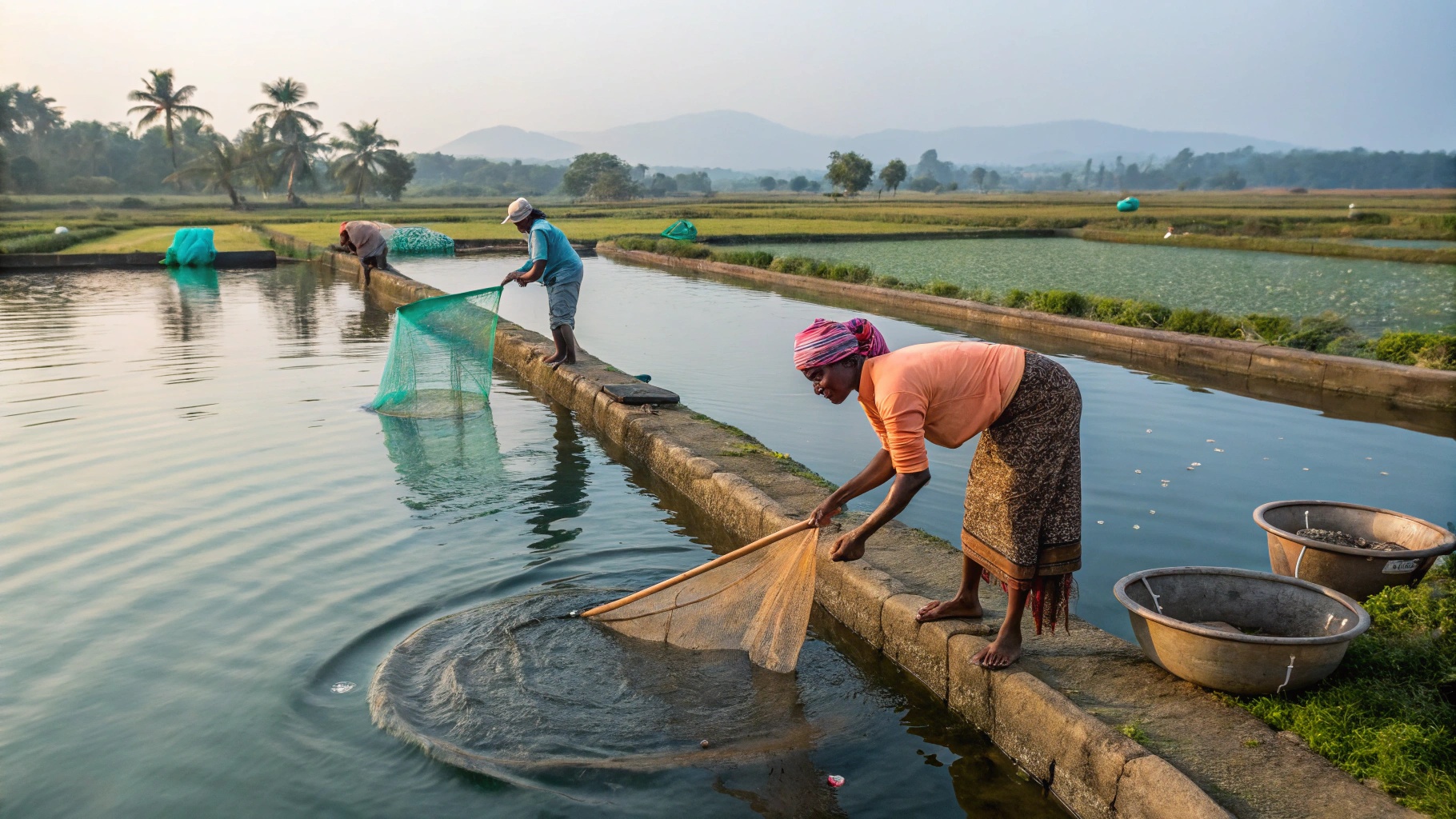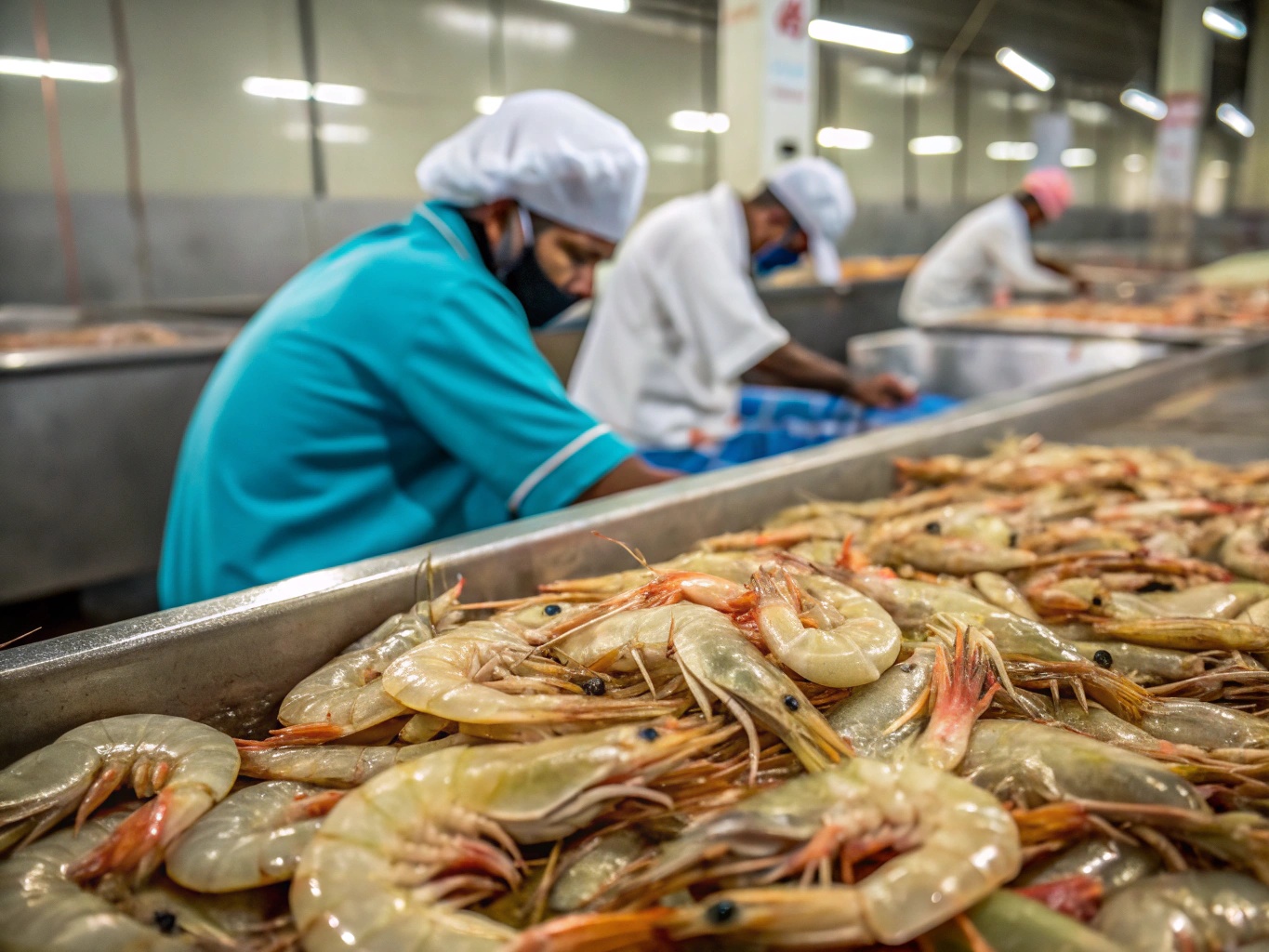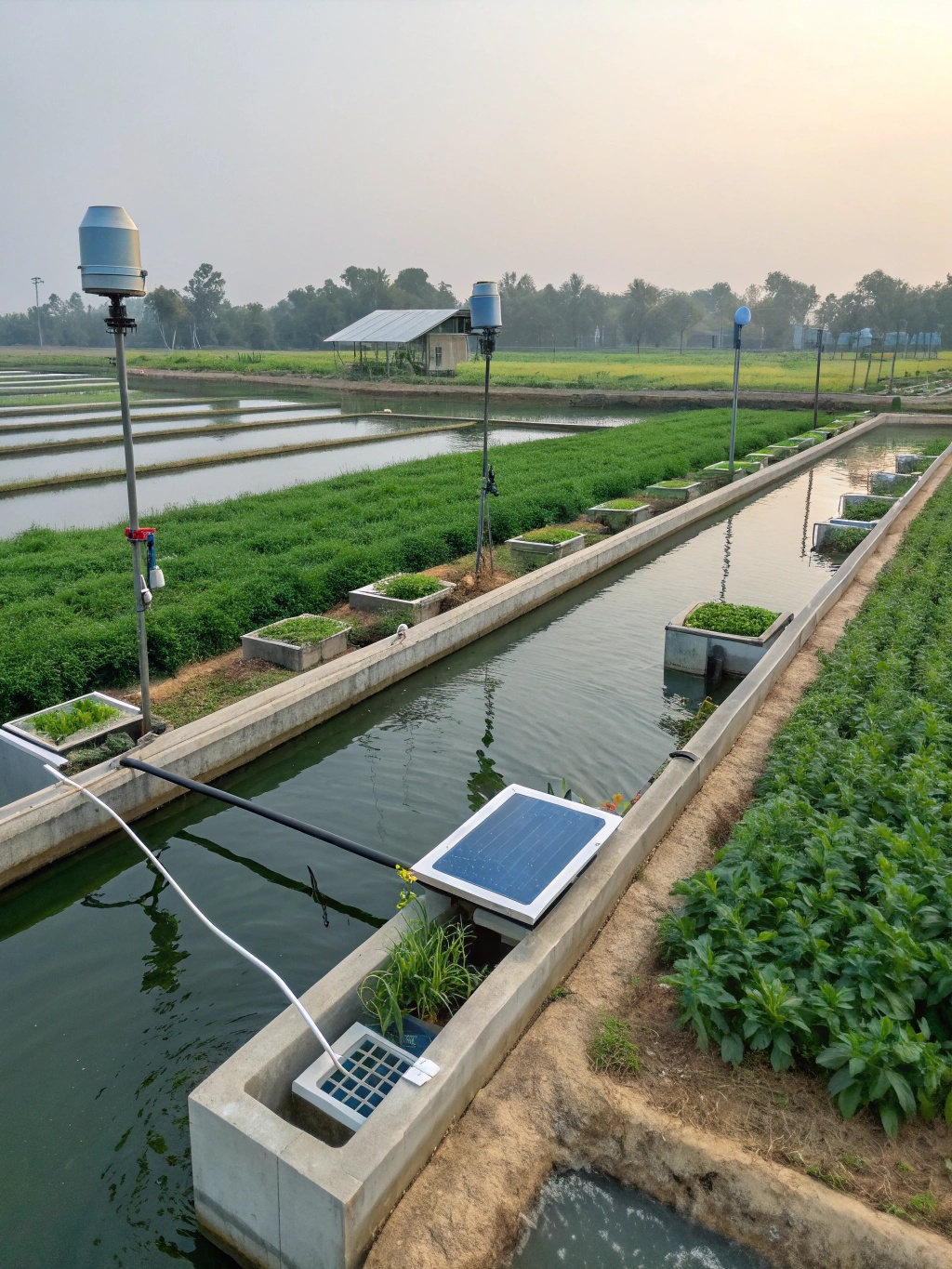Prawn Farming in India
Your Complete Guide to Successful Aquaculture
Discover the secrets of profitable prawn farming in India. From traditional methods to modern sustainable practices, learn everything you need to know about this lucrative aquaculture business.

The Growing Industry of Prawn Farming in India
India stands as one of the world's leading producers of prawns, contributing significantly to global seafood exports. With its extensive coastline stretching over 8,000 kilometers and abundant inland water resources, India offers immense potential for prawn aquaculture development.
Major Prawn Species Cultivated in India
India cultivates various species of prawns, each adapted to specific environmental conditions and market demands. Understanding these species is crucial for successful farming operations.
Penaeus Vannamei (Pacific White Shrimp)
Most PopularCharacteristics:
- Fast growth rate (18-20 weeks to market size)
- High stocking density tolerance (100-150 pieces per sq meter)
- Excellent feed conversion ratio (1.4-1.6:1)
- Hardy species with disease resistance
- Can tolerate wide salinity ranges (0.5-45 ppt)
Cultivation Details:
Originally from the Pacific coast of Central and South America, P. vannamei has become the backbone of Indian shrimp farming. Introduced in the early 2000s, this species revolutionized the industry with its superior performance characteristics.
Optimal Water Parameters:
- Temperature: 26-32°C
- Salinity: 15-25 ppt (optimal)
- pH: 7.5-8.5
- Dissolved Oxygen: >4 ppm
- Alkalinity: 120-180 ppm
Market Size: 30-40 grams in 18-22 weeks
Survival Rate: 70-85% under proper management
Production: 8-12 MT per hectare per crop
Penaeus Monodon (Giant Tiger Prawn)
Premium QualityCharacteristics:
- Largest commercial prawn species
- Distinctive tiger stripe pattern
- Excellent taste and texture
- Higher market price premium
- Requires higher salinity (15-35 ppt)
Cultivation Details:
Native to the Indo-Pacific region, P. monodon was the traditional species cultivated in India before the introduction of vannamei. Known for its large size and premium quality, it commands higher market prices but requires more careful management.
Optimal Water Parameters:
- Temperature: 28-32°C
- Salinity: 20-35 ppt
- pH: 7.8-8.3
- Dissolved Oxygen: >5 ppm
- Alkalinity: 150-200 ppm
Market Size: 40-60 grams in 20-24 weeks
Survival Rate: 60-75% under optimal conditions
Production: 5-8 MT per hectare per crop
Macrobrachium Rosenbergii (Giant Freshwater Prawn)
FreshwaterCharacteristics:
- Largest freshwater prawn species
- Blue-colored mature males with long claws
- Suitable for freshwater and low-salinity areas
- Excellent local market demand
- Can grow up to 200-300 grams
Cultivation Details:
Native to South and Southeast Asia, M. rosenbergii is ideal for inland aquaculture in freshwater areas. It offers opportunities for farmers without access to coastal areas or brackish water.
Optimal Water Parameters:
- Temperature: 26-31°C
- Salinity: 0-12 ppt
- pH: 7.0-8.5
- Dissolved Oxygen: >4 ppm
- Hardness: 100-300 ppm
Market Size: 60-100 grams in 24-28 weeks
Survival Rate: 65-80%
Production: 3-5 MT per hectare per crop
Species Selection Guide
| Factor | P. Vannamei | P. Monodon | M. Rosenbergii |
|---|---|---|---|
| Growth Rate | Fast (18-20 weeks) | Moderate (20-24 weeks) | Slow (24-28 weeks) |
| Stocking Density | High (100-150/m²) | Medium (30-50/m²) | Low (10-20/m²) |
| Water Requirement | Brackish/Marine | Marine | Freshwater |
| Market Price | Moderate | High | High (Local) |
| Disease Resistance | Good | Moderate | Good |
Comprehensive Prawn Farming Techniques
Modern prawn farming combines traditional knowledge with scientific approaches to achieve optimal production while maintaining environmental sustainability.

Pond Preparation and Construction
Site Selection Criteria
Selecting the right location is fundamental to prawn farming success. The ideal site should have:
- Water Availability: Year-round access to quality water (freshwater for freshwater species, brackish/seawater for marine species)
- Soil Quality: Clay-loam soil with good water retention capacity (pH 6.5-8.5)
- Topography: Gentle slopes (1-2%) for easy drainage and water management
- Accessibility: Good road connectivity for transportation of inputs and harvest
- Power Supply: Reliable electricity for aeration and other equipment
- Environmental Factors: Protection from strong winds and flooding
Pond Design and Construction
Proper pond design ensures optimal water circulation, easy management, and maximum production:
Pond Specifications:
- Size: 0.5-2.0 hectares (optimal for management)
- Depth: 1.2-1.8 meters (deeper ends for better oxygen levels)
- Shape: Rectangular with rounded corners for better water circulation
- Bottom Slope: 1:100 towards drain for complete harvesting
- Dyke Width: 3-4 meters at top, 6-8 meters at bottom
- Freeboard: 0.5-0.8 meters above maximum water level
Infrastructure Requirements:
- Inlet System: Separate inlet channels with screening facilities
- Outlet System: Central drain with monk system for water level control
- Aeration System: Paddle wheel aerators (1 HP per 0.2-0.4 hectares)
- Pumping System: Adequate capacity pumps for water exchange
- Security: Boundary fencing and watchman facilities
Pre-Stocking Management
Proper pond preparation is crucial for creating optimal growing conditions:
Pond Drying and Liming:
- Complete pond drying for 15-20 days
- Remove sludge and organic matter
- Apply lime (200-500 kg/hectare based on pH)
- Till the pond bottom for proper mixing
Water Filling and Treatment:
- Fill pond gradually over 3-5 days
- Screen inlet water to prevent entry of predators
- Maintain initial depth of 60-80 cm
- Apply organic manure (500-1000 kg/hectare)
- Add probiotics for beneficial bacteria development
Water Quality Parameters:
- pH: 7.5-8.5
- Dissolved Oxygen: >4 ppm
- Ammonia: <0.1 ppm
- Nitrite: <0.1 ppm
- Alkalinity: 120-180 ppm
- Turbidity: 25-40 cm (Secchi disc reading)
Seed Stocking and Early Management
Seed Selection and Quality
Quality seed is the foundation of successful prawn farming. Key selection criteria include:
Post-Larvae (PL) Quality Indicators:
- Age: PL-10 to PL-15 for marine species
- Size: 8-12 mm length
- Activity: Active swimming against water current
- Color: Transparent to light brown (species-specific)
- Uniform Size: Less than 20% size variation
- Disease-Free: No visible lesions or abnormalities
Health Testing:
- PCR testing for viral diseases (WSSV, IHHNV, YHV)
- Stress testing for survival rate assessment
- Bacterial load examination
- Hepatopancreas condition evaluation
Stocking Procedures
Proper stocking procedures ensure maximum survival and optimal growth:
Pre-Stocking Preparation:
- Acclimatize PL to pond water temperature and salinity
- Gradual mixing of transport water with pond water
- Stress reduction using vitamin C supplementation
- Stock during early morning hours (6-8 AM)
Stocking Densities:
- P. Vannamei: 100-150 PL per square meter
- P. Monodon: 30-50 PL per square meter
- M. Rosenbergii: 10-20 PL per square meter
Post-Stocking Care:
- Monitor survival rate for first 48 hours
- Start feeding with specialized starter feeds
- Maintain optimal water quality parameters
- Avoid water exchange for first 15 days
Feed Management and Nutrition
Feed Types and Composition
Proper nutrition is essential for optimal growth, health, and feed conversion efficiency:
Commercial Feed Categories:
- Starter Feed (0-30 days): 40-45% protein, 6-8% fat
- Grower Feed (30-90 days): 35-38% protein, 5-7% fat
- Finisher Feed (90+ days): 30-35% protein, 4-6% fat
Essential Nutrients:
- Protein Sources: Fish meal, soybean meal, wheat gluten
- Carbohydrates: Wheat flour, rice bran, corn meal
- Fats: Fish oil, soybean oil for essential fatty acids
- Vitamins: A, C, E, and B-complex for immune function
- Minerals: Calcium, phosphorus, zinc, selenium
- Additives: Probiotics, prebiotics, immunostimulants
Feeding Strategies
Efficient feeding strategies optimize growth while minimizing waste and environmental impact:
Feeding Schedule:
- First Month: 6-8 times daily (every 3-4 hours)
- Second Month: 4-5 times daily
- Third Month onwards: 3-4 times daily
Feed Quantity Calculation:
Daily feed quantity = Average body weight × Number of prawns × Feeding rate (%)
| Age (Days) | Body Weight (g) | Feeding Rate (%) | Feed Size (mm) |
|---|---|---|---|
| 1-15 | 0.1-0.5 | 15-20% | 0.5-0.8 |
| 16-30 | 0.5-2.0 | 10-15% | 0.8-1.2 |
| 31-60 | 2.0-8.0 | 6-10% | 1.2-1.8 |
| 61-90 | 8.0-18.0 | 4-6% | 1.8-2.5 |
| 91+ | 18.0+ | 3-4% | 2.5-3.0 |
Feeding Best Practices:
- Use feeding trays to monitor consumption
- Adjust feeding based on weather conditions
- Reduce feeding during water exchange
- Stop feeding 2-3 hours before harvesting
- Store feed in dry, cool conditions
- Use feed within 3 months of manufacturing
Water Quality Management

Water quality is the most critical factor in prawn farming success. Maintaining optimal parameters requires continuous monitoring and proactive management.
Key Water Quality Parameters
Dissolved Oxygen (DO)
- Optimal Range: 4-8 ppm
- Critical Level: Below 3 ppm causes stress
- Management: Continuous aeration, reduced stocking density
- Monitoring: 2-3 times daily, especially early morning
pH Levels
- Optimal Range: 7.5-8.5
- Effects: Affects ammonia toxicity and molting
- Management: Liming for low pH, water exchange for high pH
- Monitoring: Daily measurement
Ammonia and Nitrite
- Ammonia (NH3): <0.1 ppm (unionized)
- Nitrite (NO2): <0.1 ppm
- Sources: Feed waste, feces, dead organisms
- Management: Probiotics, water exchange, proper feeding
Salinity Management
- P. Vannamei: 15-25 ppt (optimal)
- P. Monodon: 20-35 ppt
- Adjustment: Gradual changes (2-3 ppt per day maximum)
- Benefits: Disease resistance, growth optimization
Aeration Systems
Proper aeration maintains oxygen levels and creates water circulation:
Types of Aerators:
- Paddle Wheel Aerators: Most efficient for large ponds
- Fountain Aerators: Good for deep water areas
- Diffuser Systems: Energy-efficient bottom aeration
- Venturi Systems: High oxygen transfer efficiency
Aeration Management:
- Continuous Operation: 18-24 hours during critical periods
- Strategic Placement: Even distribution across pond
- Power Requirement: 3-5 HP per hectare minimum
- Backup Systems: Alternative power sources for emergencies
Water Exchange and Biosecurity
Controlled water exchange maintains water quality while preventing disease introduction:
Water Exchange Schedule:
- First 30 days: Minimal or no exchange
- 30-60 days: 5-10% weekly
- 60-90 days: 10-15% weekly
- 90+ days: 15-20% weekly
Biosecurity Measures:
- Screen all incoming water (100-200 micron)
- UV sterilization or chlorination of inlet water
- Separate inlet and outlet channels
- Bird netting to prevent contamination
- Foot baths and hand sanitization
- Restricted access to pond areas
Health Management and Disease Prevention
Preventive health management is crucial for sustainable prawn farming. Early detection and proper treatment protocols can save entire crops from disease outbreaks.
Common Diseases in Prawn Farming
Viral Diseases
White Spot Syndrome Virus (WSSV)
- Symptoms: White spots on shell, lethargy, reduced feeding
- Transmission: Water, carriers, contaminated equipment
- Prevention: PCR testing, biosecurity, stress reduction
- Management: No cure, focus on prevention
Infectious Hypodermal and Hematopoietic Necrosis Virus (IHHNV)
- Symptoms: Deformed rostrum, stunted growth
- Impact: Reduced growth rate, survival
- Prevention: Specific Pathogen Free (SPF) seeds
Bacterial Diseases
Vibriosis
- Cause: Vibrio species bacteria
- Symptoms: Shell discoloration, lethargy, mortality
- Treatment: Probiotics, improved water quality
- Prevention: Stable water parameters, biosecurity
Luminescent Bacterial Disease
- Symptoms: Luminescence in dark conditions
- Impact: High mortality rates
- Management: Disinfection, water exchange
Preventive Health Management
Health Monitoring Protocol
- Daily Observation: Feeding behavior, swimming patterns
- Weekly Sampling: Health checks, growth monitoring
- Monthly Testing: Disease screening, water quality analysis
- Record Keeping: Detailed health and production logs
Biosecurity Measures
- Quarantine protocols for new stocks
- Disinfection of equipment and vehicles
- Restricted farm access
- Regular health screening
- Proper disposal of dead prawns
- Clean water sources
Immunostimulants and Probiotics
- Probiotics: Beneficial bacteria for gut health
- Prebiotics: Food for beneficial bacteria
- Immunostimulants: Enhance natural immune response
- Herbal Extracts: Natural disease resistance boosters
Prawn Farming as a Business
Prawn farming offers excellent business opportunities with proper planning, management, and market understanding. Success requires careful analysis of costs, revenues, and market dynamics.
Investment Analysis
Initial Investment (1 Hectare)
Revenue Projections
Production Scenarios (1 Hectare)
Conservative Scenario
- Production: 8 MT per crop
- Price: ₹350 per kg
- Revenue: ₹28,00,000
- Net Profit: ₹19,80,000
- ROI: 28-35%
Optimal Scenario
- Production: 12 MT per crop
- Price: ₹380 per kg
- Revenue: ₹45,60,000
- Net Profit: ₹37,40,000
- ROI: 45-55%
Premium Scenario
- Production: 15 MT per crop
- Price: ₹420 per kg
- Revenue: ₹63,00,000
- Net Profit: ₹54,80,000
- ROI: 65-75%
Profitability Factors
- Production Efficiency: Survival rate, growth rate, FCR
- Market Timing: Seasonal price variations
- Quality Premium: Size grading, processing standards
- Cost Management: Feed efficiency, energy costs
- Risk Management: Insurance, diversification
Market Opportunities
Domestic Market
- Growing Demand: 15-20% annual growth
- Regional Markets: Mumbai, Delhi, Bangalore, Hyderabad
- Price Range: ₹300-500 per kg (size dependent)
- Segments: Retail, restaurants, hotels
Export Opportunities
- Major Markets: USA, EU, Japan, China
- Export Price: $8-15 per kg FOB
- Quality Requirements: HACCP, BAP, ASC certification
- Processing: Value addition opportunities
Value Addition
- Processing: Peeled, deveined, cooked products
- Packaging: IQF, retail packaging
- Branding: Own brand development
- Direct Sales: Online platforms, farmer markets
Key Success Factors
Technical Expertise
Continuous learning and adoption of best practices in pond management, water quality, and health management.
Market Linkages
Strong relationships with buyers, processors, and exporters ensure consistent demand and better prices.
Risk Management
Diversification, insurance coverage, and contingency planning protect against losses and uncertainties.
Sustainability
Environmental responsibility and sustainable practices ensure long-term viability and certification opportunities.
Government Support and Schemes
The Indian government provides various schemes and support mechanisms to promote aquaculture development and farmer welfare.
Pradhan Mantri Matsya Sampada Yojana (PMMSY)
Budget: ₹20,050 crores over 5 years
Subsidy: Up to 60% for general category, 90% for SC/ST
Coverage: Infrastructure development, technology adoption
- Pond construction and renovation
- Hatchery development
- Processing and marketing infrastructure
- Boat and equipment subsidies
- Insurance support
Blue Revolution Scheme
Focus: Integrated aquaculture development
Components:
- National Fisheries Development Board (NFDB) activities
- Development of inland fisheries
- Development of marine fisheries
- Strengthening of database and information networking
- Institutional support for fisheries sector
National Mission for Protein Supplements
Objective: Increase protein availability through aquaculture
Support Areas:
- Technology transfer and extension
- Skill development programs
- Quality seed production
- Feed mill establishment
- Market infrastructure development
Financial Support and Credit
Technology and Innovation in Prawn Farming
Modern technology is revolutionizing prawn farming through automation, monitoring systems, and sustainable practices that improve productivity and profitability.
IoT and Monitoring Systems
Smart Sensors
- Real-time water quality monitoring
- Automatic dissolved oxygen measurement
- pH and temperature sensors
- Salinity and turbidity monitoring
- Mobile app integration for remote monitoring
Automated Systems
- Automatic feeders with timer control
- Aerator control based on DO levels
- Water exchange automation
- Alert systems for parameter deviations
- Data logging and analytics
Sustainable Technologies
Biofloc Technology (BFT)
- Zero water exchange systems
- Beneficial microbial communities
- Improved feed conversion efficiency
- Reduced environmental impact
- Higher stocking densities possible
Recirculating Aquaculture Systems (RAS)
- Minimal water usage
- Complete environmental control
- Higher production per unit area
- Disease prevention through isolation
- Year-round production capability
Genetic Improvements
Selective Breeding Programs
- Disease resistance development
- Faster growth rate varieties
- Better feed conversion efficiency
- Environmental stress tolerance
- Improved survival rates
SPF (Specific Pathogen Free) Stock
- Disease-free broodstock
- Certified hatchery production
- Reduced disease outbreaks
- Higher survival rates
- Consistent performance
Future Prospects and Trends
The prawn farming industry in India is poised for significant growth with emerging trends in sustainability, technology adoption, and market expansion.
Market Trends
- Growing domestic consumption (20% annual growth)
- Premium market segment development
- Direct-to-consumer sales channels
- Value-added product demand
- Organic and certified product premiums
- Export market diversification
Technology Adoption
- AI-powered farm management
- Blockchain for traceability
- Drone monitoring systems
- Mobile-based advisory services
- Precision aquaculture techniques
- Solar-powered systems
Sustainability Focus
- Carbon-neutral farming practices
- Waste reduction and recycling
- Integrated multi-trophic aquaculture
- Renewable energy adoption
- Water conservation technologies
- Certification compliance (ASC, BAP)
Emerging Opportunities
Inland Saline Aquaculture
Utilizing saline groundwater areas for prawn farming, expanding cultivation to non-coastal regions.
Integrated Farming Systems
Combining prawn farming with agriculture, poultry, and other activities for diversified income.
Processing and Value Addition
Establishing processing units, cold chains, and branded product development.
Service Sector Development
Technical consultancy, equipment supply, feed manufacturing, and logistics services.
Conclusion
Prawn farming in India represents one of the most promising opportunities in agriculture and aquaculture sectors. With its vast coastline, suitable climate conditions, government support, and growing market demand, India is well-positioned to become a global leader in sustainable prawn production.
Success in prawn farming requires a combination of technical knowledge, proper planning, adequate investment, and continuous learning. The integration of modern technology with traditional farming wisdom offers the best path forward for sustainable and profitable operations.
As the industry evolves, farmers who embrace innovation, maintain high standards of production, and focus on environmental sustainability will find the greatest success. The future of prawn farming in India is bright, with opportunities for both small-scale farmers and large commercial operations to thrive in this dynamic industry.
Ready to Start Your Prawn Farming Journey?
Contact our experts for personalized guidance and support in establishing your prawn farming operation.
Get Expert Consultation